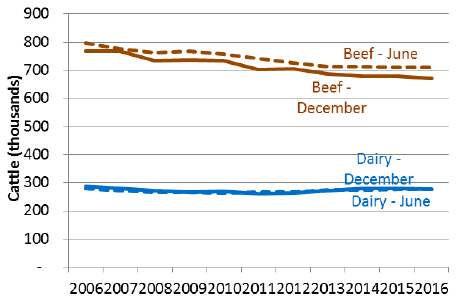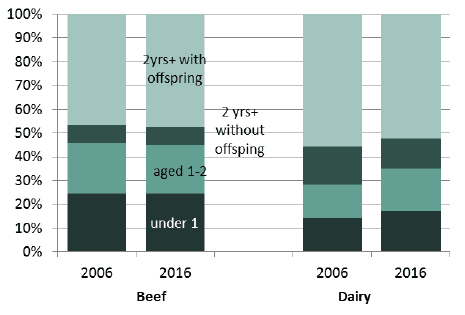Scottish agricultural survey: December 2016
Annual agricultural survey based on data from larger agricultural holdings together with estimates for smaller farms.
This document is part of a collection
5. Cattle
Year-on-year comparisons between 2015 and 2016 show:
- A decrease in total cattle of 23,900 (1.4 per cent) to 1.71 million - larger than the 0.1 per cent year on year decrease reported between June Census results. The figure is 3.5 per cent lower than the ten year average of 1.77 million.
- A decrease in the number of beef cows [3] of 3,600 (0.8 per cent) to 420,900 - in contrast to no change between the 2015 and 2016 June Census results. The figure is 4.5 per cent lower than the ten year average of 440,900.
- A decrease in the number of dairy cows [4] of 2,600 (1.5 per cent) to 174,700, a larger decrease than the 0.3 per cent decrease in the June Census results. The figure is 1.9 per cent higher than the ten year average of 171,300.
→ Insight
It is likely that short-term decisions regarding when to slaughter livestock, which may depend more on weather conditions and shorter-term price variations, are responsible for changes in beef numbers. June numbers have stabilised in recent years.
Relatively low milk prices and incentives to reduce herd size may have led to the slight drop in dairy numbers.
Chart 6 gives a comparison of trends over the past ten years for the numbers of beef and dairy cattle [5] from the December Survey and June Census. It shows that numbers vary little between December and June, though a greater seasonality is evident among beef cattle numbers.
Chart 6: Beef and Dairy cattle, June and December, 2006 to 2016

Chart 7 shows the respective age profiles of beef and dairy cattle in December. While there has been a decline in the total number of beef cattle over the last ten years, the structure of the herd has been largely consistent. Among dairy cattle however, the relatively small fall in numbers over the last ten years has been driven by a fall in older cattle, while numbers of calves and dairy cattle aged between one and two have risen over the period.
Chart 7: Age profile of beef and dairy cattle, December 2006 and 2016

Contact
Email: agric.stats@gov.scot
There is a problem
Thanks for your feedback